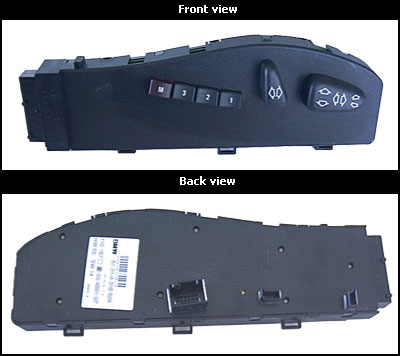 MEMORY SEATS - System Overview
MEMORY SEATS - System Overview MEMORY SEATS - System Overview MEMORY SEATS - System Overview |
| Incorporated into the switch panel of the drivers seat, it could easily be overlooked that this ECU also manages the steering column position motors which are a constant source of trouble on the L322. |
 SM060 - MEMORY SEATS - System Help file SM060 - MEMORY SEATS - System Help file |
| Version 1.27 |
 MEMORY SEATS - Known Fitments MEMORY SEATS - Known Fitments |
||||||||
Vehicle makes, models and variants known or believed to be using this vehicle system, required diagnostic lead and degree of known compatibility.
|
 MEMORY SEATS - Physical Details MEMORY SEATS - Physical Details |
 |
 SM060 - MEMORY SEATS - Diagnostic Capabilities (Read Fault Codes) SM060 - MEMORY SEATS - Diagnostic Capabilities (Read Fault Codes) |
| Reads the fault code memory. The ECU can self detect up to 29 different problems with itself, its wiring and its associated sensors, storing the respective code if it detects any malfunction or reading outside of pre defined acceptable limits. Not all stored faults may cause the fault warning lamp to illuminate. |
 SM060 - MEMORY SEATS - Diagnostic Capabilities (Clear Fault Codes) SM060 - MEMORY SEATS - Diagnostic Capabilities (Clear Fault Codes) |
| Clears the fault code memory. |
 SM060 - MEMORY SEATS - Diagnostic Capabilities (Settings) SM060 - MEMORY SEATS - Diagnostic Capabilities (Settings) |
Values, configuration settings, and other stored information which can be read from the ECU, edited and then rewritten back. Read settings can also be stored as a standard HTML page for reference. These pages can then later be re loaded and re written back to the ECU. Please note that some values may be read only due to the fact that they are supplied from the ECUís ROM or are internally calculated.
|
 SM060 - MEMORY SEATS - Diagnostic Capabilities (Inputs) SM060 - MEMORY SEATS - Diagnostic Capabilities (Inputs) |
Realtime live display of the information the electronic control unit of the selected vehicle system is currently deriving from its input sensors.
|
 SM060 - MEMORY SEATS - Diagnostic Capabilities (Outputs) SM060 - MEMORY SEATS - Diagnostic Capabilities (Outputs) |
A selection of outputs that can be tested. Each output has the option START and STOP in order to start and stop testing.
|